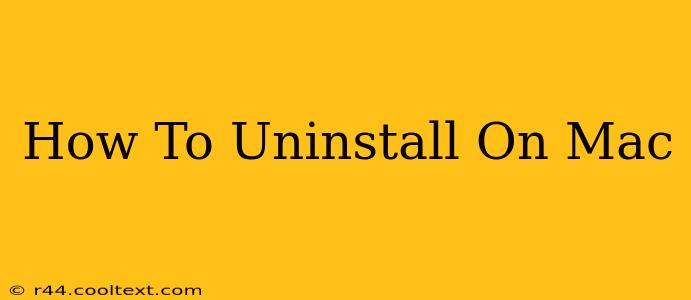Uninstalling applications on a Mac is generally easier than on Windows, but knowing the right method ensures a clean removal without leaving behind leftover files that can clutter your system. This comprehensive guide covers various techniques for uninstalling programs on your Mac, from simple drag-and-drop to using dedicated uninstaller tools.
Understanding Mac Uninstallation
Unlike Windows, Macs don't typically have a centralized "uninstall" program feature. However, most applications are self-contained within their own folders, making removal straightforward. However, some apps leave behind preference files and other data, which is why we need various methods for complete uninstallation.
Method 1: The Drag-and-Drop Method (Simple Uninstallation)
This is the quickest method for uninstalling many applications. It's suitable for apps that don't install additional components outside their main application folder.
- Locate the Application: Open your Applications folder, usually found in the Finder sidebar.
- Drag and Drop: Find the application you wish to remove and drag its icon to the Trash (or Bin).
- Empty the Trash: Right-click on the Trash icon in the Dock and select "Empty Trash." This permanently deletes the application.
Important Note: This method might not remove all associated files, such as preferences or support files. For a more thorough uninstall, consider the methods below.
Method 2: Using the Application's Uninstaller (If Provided)
Many applications, particularly larger or more complex ones, include their own uninstallers. These typically remove all associated files and settings.
- Check the Application Folder: Look within the application's folder for an uninstaller program (often named "Uninstall," "Remove," or similar). It might be a separate application or a script.
- Run the Uninstaller: Double-click the uninstaller and follow the on-screen instructions.
- Empty the Trash: Once the uninstaller completes, empty the Trash to finalize the removal.
Method 3: Manual Uninstallation (For Thorough Cleaning)
For a complete and thorough removal, manually deleting all associated files is necessary. This is more involved but guarantees a clean uninstall.
-
Identify Associated Files: Use Finder's search functionality to locate files related to the application. Search for the application's name in the following locations:
~/Library/Preferences~/Library/Application Support~/Library/Caches~/Library/Logs~/Library/Saved Application State
-
Delete Files (Cautiously!): Carefully review the files found in your search results. Only delete files that clearly belong to the application you're uninstalling. Mistakenly deleting system files can cause problems.
-
Empty the Trash: Once you're confident you've deleted all relevant files, empty the Trash.
Method 4: Using Third-Party Uninstaller Apps
Several third-party uninstaller applications are available for Mac. These tools scan your system for leftover files associated with uninstalled programs and help you remove them completely. Research and choose a reputable uninstaller if you prefer this approach. Remember to research and choose a reputable app; avoid downloading from untrusted sources.
Troubleshooting Uninstallation Issues
If you encounter problems uninstalling an application, try restarting your Mac before attempting the process again. If problems persist, consult the application's documentation or support website for specific uninstallation instructions.
This guide provides various methods for uninstalling applications on your Mac, catering to different needs and levels of technical expertise. Remember to always back up your important data before making significant system changes. By following these steps, you can ensure a clean and efficient uninstall process, keeping your Mac running smoothly.

